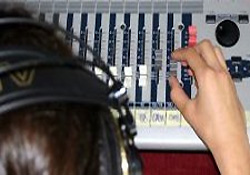
In the live environment, we can use reverb to add spatial distant in a mix.
For example, you can make backup singers “sit back” in the mix by giving them some reverb.
The more reverb, the more distance.
We can use reverb for instrumental separation. Straight on instruments with no reverb have an all-out up front sound. Adding a little reverb to a guitar or a singer and it’s like taking sandpaper to a freshly built chair – it makes it smooth.
Reverb can be used to give a song a specific feel. The more reverb, the more airy and light. Not always, but when speaking about audio, there are very few absolutes.
There are three common types of reverb; room, hall, and plate.
Room: Everything about room reverb is small. It has the characteristics of a small room. It adds a little depth and a little space. Also, it’s a short time period of reverb.
Hall: “WELCOME TO THE VELODROME-OME-OME-OME-OME!” Hall reverb lasts a longer period of time and carries more reflection. It carries a larger fuller sound. The smallest of halls is still bigger than the largest of rooms.
Plate: Plate reverb is the sound a plate makes when you accidentally drop it in the kitchen and the sound echoes throughout the house…OK, maybe not.
Plate reverb does not emulate any specific space. It is created through sound vibrating a metal plate at the end of a tube. This metal plate vibrates rapidly, and this “reverbed” sound carries a lot of early reflection. You might even say it has a heavy feeling.
Plate reverb is popular with drums. A benefit of plate reverb is it gives the thicker sound you might associate with a hall reverb but for a shorter period of time.
The next time you start your mixing, remember that reverb carries a lot of power that’s just waiting to be unleashed.
Oops, I almost forgot…when mixing, EQ your instruments before you add any reverb. Going back to the sandpaper analogy, you always use sandpaper last.
Ready to learn and laugh? Chris Huff writes about the world of church audio at Behind The Mixer. He covers everything from audio fundamentals to dealing with musicians. He can even tell you the signs the sound guy is having a mental breakdown.
